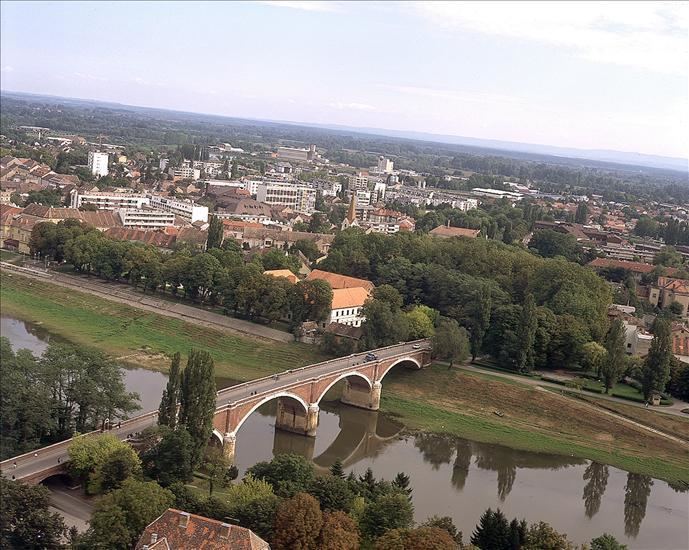Elevation 98 m (321.52 ft) Postal code 44000 Area 422.8 km² Local time Thursday 2:22 AM | County Sisak-Moslavina Time zone CET (UTC+1) Population 47,768 (2011) Area code 044 | |
 | ||
Weather 11°C, Wind SW at 3 km/h, 80% Humidity | ||
Sisak croatia
Sisak ([sǐːsak]; also known by other alternative names) is a city in central Croatia located at the confluence of the Kupa, Sava, and Odra rivers, 57 km (35 mi) southeast of the Croatian capital Zagreb. The city's total population in 2011 was 47,768 of which 33,322 live in the urban settlement (naselje).
Contents
- Sisak croatia
- Map of Sisak Croatia
- Name
- Geography
- Roman period
- Middle Ages
- Early modern
- Modern
- Contemporary
- Demographics
- Education
- Miscellaneous
- Twin towns Sister cities
- References
Map of Sisak, Croatia
Sisak is the administrative centre of the Sisak-Moslavina County, Croatia's biggest river port and a centre of river shipping industry (Dunavski Lloyd). It lies on the main road Zagreb-Sisak-Petrinja (M12.2) and the railroad Zagreb-Sisak-Sunja. Sisak is a regional economic, cultural and historical center. The largest oil refinery in Croatia is located here.
Name
Prior to the invasion by the Roman Empire, the region was Celtic and Illyrian and the city there was named Segestica.
In German the town is known as Sissek, in Hungarian as Sziszek, Latin as Siscia and in Kajkavian and Slovene as Sisek.
Geography
Sisak is situated at the confluence of three rivers, the Sava, the Kupa and the Odra, and is usually considered to be where the Posavina (Sava basin) begins, with an elevation of 99 m.
Roman period
During the Roman Empire when Sisak was known as Siscia, a Roman mint in the city produced coins under a series of emperors between 262 and 383 AD. It was in this period that the Christian martyr Quirinus of Sescia was tortured and nearly killed during Diocletian's persecution of Christians. Legend has it that they tied him to a millstone and threw him into a river, but he freed himself from the weight, escaped and continued to preach his faith. Today he is the patron saint of Sisak.
Middle Ages
Braslav of Lower Pannonia reigned from Sisak until he was killed in the Hungarian invasion ca. 898. According to Historia Salonitana, Duke Tomislav reclaimed it soon after.
Early modern
The 16th-century triangular fortress of the Old Town, well-preserved and turned into the Native Museum, is the main destination of every tourist. The fortress is famous for the victory of the joint forces of Croats, Austrians and Carniolans (Slovenes) over the Ottomans in 1593, known as the Battle of Sisak. It was one of the early significant defeats of the up-to-then invincible Ottoman army on European territory. The Croatian Ban Thomas Erdődy who led the defense in this battle became famous throughout Europe. The Baroque palace of Mali Kaptol, the classicist Veliki Kaptol, the brick Stari most ("Old Bridge") over the Kupa, and the ethnological park are the most frequently visited landmarks.
Modern
In the late 19th and early 20th century, Sisak was a district capital in the Zagreb County of the Kingdom of Croatia-Slavonia.
Contemporary
From 1929-39, Sisak was part of the Sava Banovina and from 1939-41 of the Banovina of Croatia within the Kingdom of Yugoslavia. During World War II, Sisak children's concentration camp was set up by the Croatian Axis Ustaše government for Serbian, Jewish and Romani children. It is estimated that 1,152–2,000 children were killed in the camp.
With the outbreak of the Croatian War in 1991, Sisak remained in Croatian hands while the territory to the south was controlled by Serbs. In 1991-92, the Croatian Army killed 611 civilians in Sisak, of whom 595 were Serbs, 14 Croats and 2 Bosniaks, according to Domagoj Margetić sr.
During the war, the Serb forces often shelled the city, causing dozens of civilian casualties and extensive damage to the city's industry. The war ended with the Operation Storm (1995), which led to 150,000–200,000 ethnic Serbs fleeing Croatia; the number of Serbs in Sisak decreased from 12,017 (1991) to 3,897 (2001).
Demographics
The city administrative area is composed of the following settlements:
In the 2011 census, of the total population of 47,768 there were 40,590 Croats (84.97%), 3,071 Serbs (6.43%), 1,646 Bosniaks (3.45%), 648 Romani (1.36%), 179 Albanians (0.37%), 29 Montenegrins (0.06%), and the rest were other ethnicities. In the 2011 census, the population by religion was 37,319 Roman Catholics (78.13%), 3,279 Orthodox Christians (6.86%), 2,442 Muslims (5.11%), and others.
Education
The city hosts University of Zagreb's Faculty of Metallurgy.
Miscellaneous
Chief occupations are farming, ferrous metallurgy (iron works), chemicals, leather (footwear), textiles and food processing plants (dairy products, alcoholic beverages), building material, crude oil refinery, and thermal power.
Sisak features the largest metallurgic factory and the largest oil refinery in Croatia. Sisak has many rich mineral springs (spas) with healing properties in the temperature range from 42 to 54 °C (108 to 129 °F).
Sports and recreation facilities in the town and the surroundings include mainly the waters and alluvial plains a public beach on the Kupa. All rivers (Kupa, Odra, Sava) with their backwaters offer fishing opportunities. There are hunting grounds in the regions of Turopolje and Posavina. Sisak is the starting point for sightseeing tours into Lonjsko Polje (Field of Lonja river) nature park. The local football club is HNK Segesta. Sisak features the oldest ice hockey club in Croatia, KHL Sisak est. 1934.
Twin towns — Sister cities
Sisak is twinned with:
